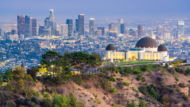Nestled within the heart of Los Angeles County, Beverly Hills stands as the epitome of opulence and glamour. Its name alone conjures images of palm-lined streets, upscale boutiques, and lavish lifestyles. However, beyond the façade of wealth lies a captivating history, tracing its roots to a remarkable journey of transformation and vision. From humble ranch land to an iconic symbol of elegance, Beverly Hills’ journey is a testament to the power of vision and transformation. Its history is woven with threads of innovation, luxury, and cultural diversity, creating a city that captivates the world’s imagination.
Native History
In the beginning, Beverly Hills was blessed with the precious commodity of water. Native American inhabitants, the Tonga, considered it a sacred site, naming it ‘Gathering of the Waters.’ Before the arrival of Spanish conquistadors, the Tonga led a peaceful life, nurtured by the abundance of game and vegetation in the area. They followed an animistic religious practice inspired by an environment filled with colors, making present day Beverly Hills a desirable destination.
In 1769, contact between peaceful natives and Europeans occurred north of what is now Olympic and La Cienega boulevards. With them, they brought a smallpox epidemic, destroying two-thirds of the Native population over the next 100 years.
Early Modern History
The story of Beverly Hills commences in the late 19th century, when the land was primarily used as ranch land and lima bean fields. In 1900, Burton E. Green, a prominent banker, purchased a substantial tract of this land, laying the foundation for the city’s future. The early visionaries saw potential beyond the agricultural landscape, imagining an exclusive residential community that would redefine luxury living.
The partnership between Margaret J. Anderson and her husband, George W. Anderson, catalyzed the transformation of Beverly Hills. Their ambitious vision was to create a glorious retreat, marked by meticulously planned streets and grand residences. The Andersons’ dream gained momentum after successfully convincing other influential figures to invest in their vision, including legendary oil magnate Edward L. Doheny.
The Pink Palace & Entertainment Industry

The allure of Hollywood and the burgeoning entertainment industry cast a significant influence on Beverly Hills’ trajectory. As the motion picture industry flourished, luminaries of the silver screen sought refuge in the city’s lavish estates. This marked the beginning of a long-standing association between Beverly Hills and the entertainment world, culminating in its reputation as the “Entertainment Capital of the World.”
Transformation
The architectural landscape of Beverly Hills underwent a transformative phase during the 1920s and 1930s. Renowned architects such as Wallace Neff and Paul Williams played pivotal roles in shaping the city’s distinctive aesthetic. Their innovative designs gave rise to Mediterranean Revival, Spanish Colonial Revival, and Georgian Revival mansions, each a testament to the city’s evolving identity.
No exploration of Beverly Hills’ is complete without a visit to Rodeo Drive. Established in the 1960s, this world-renowned shopping district became synonymous with luxury and fashion. Its boutiques, from iconic brands to independent designers, attract discerning shoppers from around the globe.
By the mid-20th century, Beverly Hills had firmly established itself as an economic powerhouse. The city’s commercial landscape flourished with high-end boutiques, luxury brands, and upscale restaurants. Rodeo Drive, with its exclusive shopping boutiques, became a global symbol of luxury and fashion, attracting visitors and celebrities alike.
Embracing Change: Beverly Hills’ Transformation in Culture and Sustainability
As the 20th century progressed, Beverly Hills evolved into a vibrant and diverse community. The city welcomed residents from around the world, contributing to its rich cultural tapestry. The melding of traditions and ideas infused Beverly Hills with a unique character, reflected in its diverse neighborhoods, international cuisine, and artistic expressions.
In recent years, Beverly Hills has embraced sustainable practices and environmental stewardship. The city’s commitment to renewable energy, waste reduction, and eco-friendly initiatives exemplifies its dedication to a greener future. As Beverly Hills continues to adapt and innovate, its legacy as a global center of luxury and culture remains unwavering.
Moving into the 21st Century, the city added two new attractions: the 9/11 Memorial, a construction made with actual steel beam recovered from the ruins of the World Trade Center, and the Wallis Center for the Performing Arts, a cultural resource with a flexible 150-seat theatre, a theatre school with three classrooms, a café, and gift shop.
As Beverly Hills approached its 100th anniversary of its incorporation, concerns began to increase over the lack of a historical preservation ordinance to protect significant structures within the city limits. In response, the City Council enacted one with the honor of Historic Landmark bestowed upon the Beverly Hills Hotel. Since its centennial in 2014, Beverly Hills has continued to mature with a renewed appreciation for its past, from native history, to the city’s commitment to diversity and sustainability, remaining true to Burton Green’s vision of an oasis of refinement, while meeting the challenges of the future.







